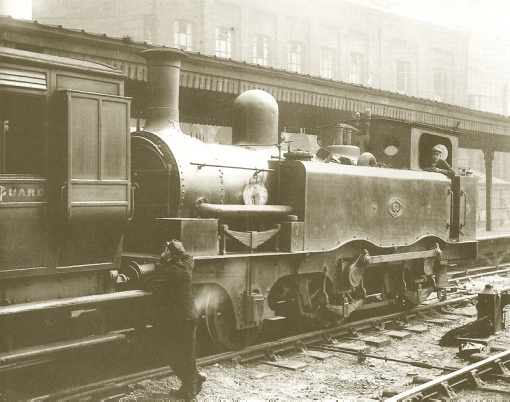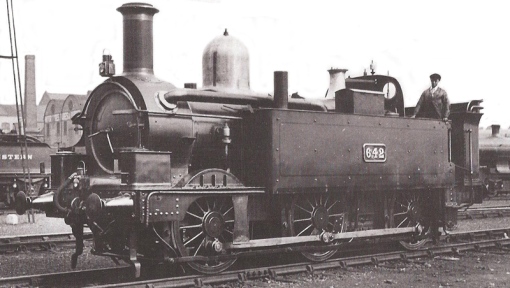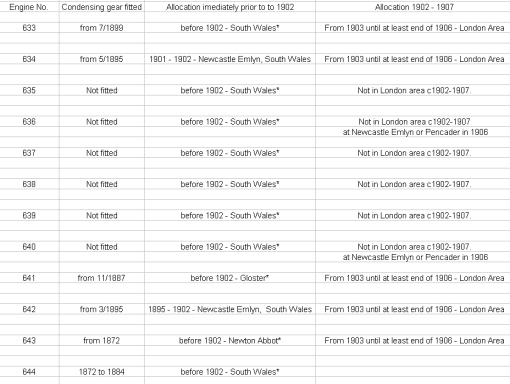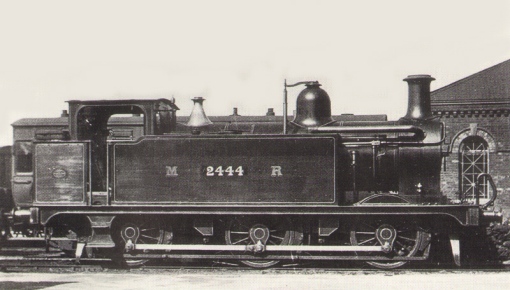May 2010
Monthly Archive
May 27, 2010

Designed by Crampton, these were the first six locomotives built for the Company. The ‘Sondes’ (named after one of the Directors), were delivered as 4-4-0STs in 1857, and were complete failures, suffering from a plethora of design and construction flaws. When William Martley became Locomotive Superintendent in 1860, he relegated the class to minor duties until they were unceremoniously shoved up a siding at Faversham and forgotten about until finally, in 1865, he gave in to a persistent Lord Sondes who had been regularly exhorting him to rebuild them at the monthly board meetings.
It is not on record just how much of the original locomotives were salvaged to be incorporated into the rebuilds; the Engine Register only mentions the boilers, but Bradley, in his RCTS book on the History of Chatham locomotives, suggests that ‘rebuild’ was hardly the correct terminology, and the Accountant’s Register names them ‘Second Sondes’ (some tertiary sources label them ‘New Sondes’), which insinuates that very little was reused.
Whatever the truth, the new double-framed 2-4-0Ts were a neat and very attractive class, and more to the point, became very successful on the suburban duties in which they were employed. Their styling was very similar to Martley’s three other 2-4-0T designs, the Rose, Ruby and Aeolus classes, and with the opening of the Metropolitan Extensions, were fitted with condensing apparatus and put into service alongside the Scotchmen, where they spent many years in service on City trains.
Reboilered in the 1870s, the six members of the class were given enclosed cabs and promptly resumed their duties between Victoria and Moorgate Street until the opening of the Extended Widened Lines, when services then terminated at Basilica Fields.
Number 63, formally named Faversham, will represent the class on Basilica Fields, and is seen here at the turn of the 20th Century at Victoria, under SECR ownership, but still wearing the LCDR livery. It was again reboilered in 1907 as SECR No.522, before being withdrawn in September 1909. Not much chance of a kit appearing on the market, so it’s going to be another scratchbuild.
May 25, 2010

Passenger services from three companies originating south of the Thames will feature on Basilica Fields, viz; the London Brighton and South Coast Railway, the South Eastern Railway, and the London Chatham and Dover Railway. The latter, known as the East Kent Railway until 1859, was empowered under the Metropolitan Extension Act of 1860 to build a line from Beckenham to Herne Hill where a junction took a line north west to Victoria, and another due north towards the then projected Metropolitan Railway at Farringdon Street (then known as Victoria Street). The line to Victoria was complete three years later, and the City line was opened as far as Blackfriars Bridge in June 1864. Within six months the line had crossed the Thames to a temporary station, Ludgate Hill, but the final stretch from there to an end-on junction with the Metropolitan at West Street took considerably longer as it fell foul of inspections by the Board of Trade, and it wasn’t until the beginning of 1866 that all objections were satisfied, and the line opened.
LCDR services from Ludgate Hill to the GNR terminus at Kings Cross and back commenced immediately, and within two days the GNR was itself running trains between the two stations. Eventually the long arm of the LCDR reached into both Middlesex via the GNR and Midland, and Hertfordshire, with services from Victoria or Herne Hill to destinations such as Hatfield, Enfield, Kentish Town, Hendon, and Alexandra Palace.
Key to Basilica Fields, a eastwards spur between Snow Hill and the Great Western Railway’s depot at Smithfield was proposed, to which the BoT objected, due to the safety aspect of the flat crossing between the spur and the outward line from the depot. After much petitioning, the BoT relented, and the spur was eventually sanctioned in 1871, so Moorgate Street became an alternative destination for the Chatham until the Extended Circle was rolled out in the late 1880s, and Basilica Fields became the terminus for Chatham trains.
The RCH Junction diagram from the turn of the century shows the relationship between the Chatham, the Metropolitan and the Widened Lines companies, although as the diagram is dated post-1899, the Chatham line comes under the aegis of the SECR Committee.
May 17, 2010

I thought that this class, the final type of Great Western condensing locomotives to operate on the Metropolitan lines (until the introduction of the 97xx class in the 1930s), and therefore Basilica Fields, was going to be an easy one to deal with, after all, the books and articles I’ve seen detailing the GWR’s presence on the Metropolitan line write frugally, but broadly in agreement, upon their role on the goods service from Acton to Smithfield…but scratch the surface, and the reality is not quite so clear cut.
Built at Wolverhampton between November 1871 and April 1872, this class of twelve 0-6-0Ts were always Southern Division locos, and over the years some of the class were fitted with condensing equipment to work the Metropolitan lines.
What follows is a précis of the information in print:
They were the first six-coupled engines to be accepted for the Widened Lines, some twenty years in advance of the much larger and heavier Great Northern saddle tanks. Steam on the Widened Lines Vol.2 p.10. Geoff Goslin.
This implies the 633 were used on the Widened Lines from 1872 as the GNR 921 Series of saddle tanks were released to traffic in 1892. However, RCTS disagrees, and in its segment on the 2-4-0T Metro class, states:
The name of this class [the 2-4-0T Metro tanks] is derived from the engines’ association with the Metropolitan Railway, over which so many of them worked, they being the only GWR engines to do so during the latter part of the nineteenth century. RCTS The Locomotives of the Great Western Railway Part Six, p.F29.
With the absence of primary sources, if I had to choose between the two I’d plump for RCTS, although the Society’s publications are not infallible. However things now begin to get murky as RCTS also states:
Those with condensers were stationed in the London area for working over the Metropolitan line, whilst the non-condensing engines were mostly in South Wales, in the Neath Division. RCTS The Locomotives of the Great Western Railway Part Five, p.E34.
Condensing apparatus was fitted to 643/4 as built, but was removed from the latter in September 1884. RCTS The Locomotives of the Great Western Railway Part Five, p.E34.
There are discrepancies in the accounts of those fitted with condensers at this period, but it is fairly certain that Nos.633/4/41/42/43 were so fitted when rebuilt or shortly afterwards and remained so. RCTS The Locomotives of the Great Western Railway Part Five, p.E34.
The condensing engines remained without cabs until withdrawn in 1933-4. RCTS The Locomotives of the Great Western Railway Part Five, p.E34.
643 had always been a condensing engine. RCTS The Locomotives of the Great Western Railway Part Five, p.E34.
The implication of these quotes being that those fitted with condensers were allocated to the London Division only, all such locos being cabless for working through the Metropolitan tunnels, and those allocated to South Wales were fitted with cabs and did not carry condensers. However…
Surviving GWR Loco Allocation Registers only go back as far as 1902 (it has been suggested that possibly the 1902 one was the first such Register), and at the beginning of that year it is recorded that not one of the 633 class was allocated to the London Division, and (it would appear, if the RCTS opinion on the matter is to be believed) several of those in Wales were condenser fitted! Graham Beare saved me from too munching my way though too much paracetamol by sending the information in the following table (sorry for the slightly blurry image, please click for a clearer version), which collates info from both RCTS and the Register, followed by a suggestion as to which locos would be appropriate for Basilica Fields, post-1902:

N.B. * period of allocation indeterminate.
Graham writes:
In this instance, London Area means that an engine has been recorded as allocated to a shed within the London Division, examples noted include:- Paddington, Southall, Staines, Slough, Henley-on-Thames, Aylesbury, Watlington…. as far as I can see, there was no allocation to Reading, Didcot, Oxford. From this information, I suggest that the most likely candidates for your needs are 641, 642 and 643 which were Southall engines for most of the period from 1902 to 1906 and the most likely to be in charge of services over the widened lines.
The Registers are in the National Archive, and the 1902 Register can be found at RAIL 254 / 60. I’d like to thank John Lewis at this point for supplying digital copies of the relevant pages via Graham.
The photo of 642 is irresistible, and places it in London in pre-1906 livery, so spot on for the later period of Basilica Fields.
I’ve an old Mega (ex-Gateneal) kit of the 633 class, but I suspect that most of it will be binned – not necessarily because of any fault in the kit itself (though it is verybasic compared to modern offerings), but because it represents a much later version of the locos with different side tanks and enclosed cabs, and scratchbuilding looks increasingly likely.
May 14, 2010

In 1899, Johnson unveiled the first of what would become a class of 60 new goods tank locos, the 2441 class. Descendants of the 1102 class and antecedents of Fowler’s 3F ‘Jinties’, the first thirty of the class had condensing equipment from new for working the sub-surface lines in London between the various goods depots, and carried various detail differences which separated them from their normally aspirated sisters. To counter the side tanks from being blistered from the very hot water passing through the condensing pipes – a problem encountered on other lines, for example the Great Eastern – an outer skin was fitted to the tank sides with a small airspace between. This arrangement produced a squared front corner to the tanks with pairs of cooling slots on the front edge, whereas the normally aspirated locos without the outer panel had rounded tank corners.
Those allocated to London were initially painted and lined in the highly decorative ‘London style’ of crimson lake with almost everything above and below the footplate lined out. No. 2444 is seen here on 6th June 1903 at Cricklewood in just such a livery, and despite appearing at first glance to be in ex-works condition (a misused phrase so beloved of authors of books and magazines), it instead bears the marks of hard work on the Widened Lines; traffic dust and grime haze over the wheels, underframe, valence, bunker and tank sides – the numbers have had attention from the tallow cloth to make them appear clearer, and there are signs of a hot smokebox and chimney too. It’s worth noting the slightly shorter boiler fittings, especially the chimney and dome, and especially the arrangement of the Salter valves, with the pillars attached to the sides of the tank rather than the top of the boiler.
May 12, 2010

This is the second instalment seeking to précis the Great Western Railway’s Metropolitan tanks on Middle Circle services. The first part dealt with a little history and the Medium-sized Metros, and here I’ll deal with the large-tank series.
In January 1899 the first of twenty new Metros was released to traffic with large 1100 gallon tanks. Volute springs replaced the leaf springs over the leading axleboxes due to space considerations, and following on from the previous Lot of Medium Metros in 1894, the new locos were all built with the dome on the back ring of the boiler. One month after the introduction of the larger tanks the first of thirty condensing Medium Metros was sent to Swindon to be given larger 1080 gallon tanks, and by the end of the year there was a total of fifty large condensing Metros in service for Inner London traffic.
The final decade of the 19th Century and the first six years of the 20th were the busiest for the condensing members of the class in the City; single-handedly they dealt with through services from the main line to Aldgate, the Middle Circle services from Mansion House via Earls Court, Addison Road, and Bishops Road to Aldgate, half the trains on the Hammersmith & City service to Aldgate via Bishops Road, and most trains on the Aldgate to Richmond via Bishops Road, Grove Road Junction and Gunnersbury, and of course the Extended Widened Lines Services to Basilica Fields.
From 1900 the Middle Circle service was cut back from Mansion House to Earls Court, and in 1905 trimmed again to Addison Road. Electrification of both the Circle and the Hammersmith & City in 1906 prompted the first withdrawals of the class, and stripped all bar six of their condensing apparatus. Limited services continued on the Extended Circle to Basilica Fields until 1913 when that line was electrified alongside the East London Railway.
No.1407 was released to traffic in June 1878 as a medium Metro to Lot 47. In June 1898 it was reboilered, given large tanks and volute springs, and is seen here sometime between 1898 and early 1906 stationed at Paddington. The loco is heavily stained and weathered from working in the Metropolitan tunnels, and shows that even the proud Great Western in the pre-Grouping era wasn’t as shiny and sparkly as many modellers presume.
Next Page »





